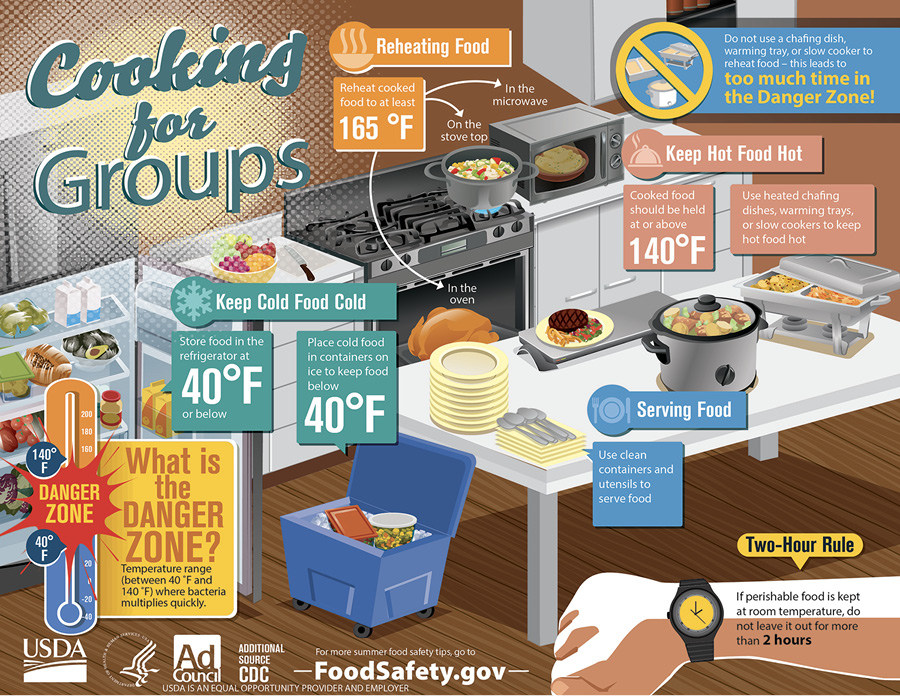Holiday Food Safety

Holidays are a fun and festive part of the year filled with family, friends, and food. Holiday celebrations can be a full day of socializing with guests, and while entertaining guests is fun, it is important to serve your guests safe food. Following these food safety steps will help to make sure your food is prepared, cooked, served, cooled, and stored safely.
Handwashing
With so many dishes to prepare, it is important to keep them all safe to eat. One of the best and easiest ways to keep food safe is to wash your hands. Wash your hands with soap under warm, running water for at least 20 seconds before and after working with food. During food preparation, wash your hands when you change ingredients and, most importantly, after working with any raw meat, poultry, or eggs.
Follow these five steps every time:
- Wet your hands with clean, running water (warm or cold), turn off the tap, and apply soap.
- Lather your hands by rubbing them together with the soap. Then lather the backs of your hands, between your fingers, and under your nails.
- Scrub your hands for at least 20 seconds. Need a timer? Hum the “Happy Birthday” song from beginning to end twice.
- Rinse your hands well under clean, running water.
- Dry your hands using a clean towel or paper towel, or air dry them.
For more information:
When and How to Wash Your Hands (Centers for Disease Control and Prevention)
https://www.cdc.gov/handwashing/when-how-handwashing.html
Clean and Sanitize
Keeping your kitchen workspace clean is important to stop the spread of bacteria. Cleaning and sanitizing is a two-step process! Before preparing food, start with a clean and sanitized counter and clean cooking utensils. Once you are finished preparing and cooking foods, be sure to clean and sanitize the countertops again.
- Cleaning is the process of removing food and other types of soil from a surface, such as a dish, glass, or cutting board, using hot, soapy water.
- Be sure to clean dishes and counter tops with hot, soapy water after each use and after each food item is prepared.
- Use hot, soapy water frequently to keep surfaces, equipment, and utensils clean. You can also use the dishwasher to clean dishes and utensils.
- Clean cutting boards, knives, and other cooking utensils often to reduce or limit bacterial spread and cross-contamination.
- After cleaning cutting boards and other surfaces with hot, soapy water, rinse them thoroughly under running water, then sanitize them.
- Sanitizing is a process that reduces the number of harmful microorganisms on a properly cleaned surface to a safe level.
- After cleaning, use a household disinfectant that is safe for kitchen use (read and follow the manufacturer’s instructions on the bottle) OR prepare a bleach solution of 1 tablespoon of unscented liquid chlorine bleach per gallon of water.
- Spray the solution onto surfaces, equipment, and utensils; let it air dry, or pat dry with paper towels.
Some other tips:
- Use separate cutting boards for fresh produce, raw meats, and ready-to-eat (RTE) foods.
- Wash fruits and vegetables under running water before eating them.
- You do not need to wash or rinse meat, poultry, or eggs! Washing these items may cause cross-contamination.
For more information:
4 Steps to Food Safety (U.S. Department of Health and Human Services)
https://www.foodsafety.gov/keep-food-safe/4-steps-to-food-safety#clean
Thaw Safely
The safest way to thaw products, including meat or poultry, is in the refrigerator at 40°F or below. If you do not have time to fully thaw in the refrigerator, you can also place the frozen food under cool, running water or carefully microwave it. However, if you use these methods, the products must be cooked immediately once thawed. You can cook products that are frozen, but they will take longer to cook.
After a dish has been fully cooked, be sure to use new plates, bowls, and utensils to handle it to prevent cross-contamination.
For more information:
The Big Thaw – Safe Defrosting Methods for Consumers (U.S. Department of Agriculture Food Safety and Inspection Service)
Temperature Control
Cooking
When cooking a dish, especially meats, know what the final internal temperature should be. Recipes often give an approximate time for how long the dish will need to cook, but this time may not work for your dish or equipment. The only way to know if a food has reached the right internal temperature is to use a food thermometer. Insert the food thermometer into the food or dish in the thickest part, without touching bone, fat, or gristle.
For more information:
Safe Minimum Cooking Temperature Charts (U.S. Department of Health and Human Services)
https://www.foodsafety.gov/food-safety-charts/safe-minimum-cooking-temperature
Kitchen Thermometers (U.S. Department of Agriculture Food Safety and Inspection Service)
Test the Temperature – Use a Thermometer for Food Safety (Dietitians of Canada)
Cooling
Most foodborne illness-causing bacteria grow best from 40°F to 140°F; this temperature range is called the temperature danger zone. Hot dishes need to be cooled to below 40°F as quickly as possible. For larger dishes such as soup, the dish should be cooled to below 70°F within the first 2 hours.
Never place a hot dish directly in the refrigerator. The heat radiating from the dish can warm surrounding food up above 40°F, compromising its safety. The best way to cool a dish is in a shallow storage container. You can also place the hot container in an ice bath and stir the hot food to help redistribute the heat. These methods help the food cool quickly and evenly, so you can place the dish in the refrigerator sooner.
Tip: All fully cooked and ready-to-eat foods should be stored above raw foods to prevent cross-contamination from dripping.
For more information:
Keep Food Safe with Time and Temperature Control (University of Minnesota Extension)
https://extension.umn.edu/food-service-industry/keep-food-safe-time-and-temperature-control
Serving
Now that you have prepared your dishes, it is finally time to enjoy them. Keep in mind that properly serving foods is just as important to food safety as the preparation. Any hot food that was prepared ahead of time must be reheated to 165°F before serving. For dishes served cold, store them in the refrigerator until you’re ready to serve them.
Foods must be reheated or cooled to the appropriate temperature within 2 hours of being served. So, even though it may be hard after such a delicious and filling meal, it is important to get any leftovers into the refrigerator as soon as possible. This will reduce the chances of bacterial growth contaminating the leftovers.
For more information:
Danger Zone (40°F–140°F) (U.S. Department of Agriculture Food Safety Inspection Service)
Buffets
Buffets are popular for holiday parties. Guests can come and eat as they please, making it ideal for all-day parties. It is very important to follow food safety guidelines to keep buffet foods safe. Keeping perishable dishes out of the temperature danger zone (40°F–140°F) is a major concern. Hot foods must be kept hot (above 140°F), and cold foods must be kept cold (below 40°F). Slow cookers, warming trays, and chafing dishes are great for keeping hot foods hot. Keep cold foods, like dips or cold meats, cold by placing them on ice.
Another way to keep buffet foods safe is to use small dishes, which can easily be finished and replaced within 2 hours. In addition, it is best to remove and replace an empty or nearly empty dish instead of replenishing it. This will prevent cross-contamination from foods that have been in the danger zone to those that were held properly.
You should also change or wash the serving utensil when bringing out a new tray or dish. The old serving utensil could cause cross-contamination between the old and new trays.
Keep an eye on the amount of time each dish has been out. Even when serving smaller portions, if a dish has been at room temperature for more than 2 hours, it must be thrown away. This will help keep the dish safe throughout the party.
For more information:
Food Safety for Buffets and Parties (Centers for Disease Control and Prevention)
https://www.cdc.gov/foodsafety/serving-food-safely.html
References and Resources
Centers for Disease Control and Prevention (CDC). Food Safety for Buffets and Parties.
Centers for Disease Control and Prevention (CDC). When and How to Wash Your Hands.
Dietitians of Canada. Test the Temperature – Use a Thermometer for Food Safety.
Foodsafety.gov. U.S. Department of Health and Human Services. Safe Minimum Cooking Temperature Charts.
Foodsafety.gov. U.S. Department of Health and Human Services. 4 Steps to Food Safety.
U.S. Department of Agriculture Food Safety Inspection Service (USDA-FSIS). Holiday or Party Buffets.
U.S. Department of Agriculture Food Safety Inspection Service (USDA-FSIS). Leftovers and Food Safety.
U.S. Department of Agriculture Food Safety Inspection Service (USDA-FSIS). Danger Zone (40°F–140°F).
U.S. Department of Agriculture Food Safety Inspection Service (USDA-FSIS). The Big Thaw – Safe Defrosting Methods for Consumers.
U.S. Department of Agriculture Food Safety Inspection Service (USDA-FSIS). Kitchen Thermometers.
U.S. Food and Drug Administration (FDA). Serving Up Safe Buffets.
U.S. Food and Drug Administration (FDA). Holiday Food Safety.
U.S. Department of Health and Human Services. 4 Steps to Food Safety.
University of Minnesota Extension. Keep Food Safe with Time and Temperature Control.
Publication 3453 (POD-05-23)
By Courtney A. Crist, PhD, Associate Extension Professor, Food Science, Nutrition, and Health Promotion. Prepared by Rebecca Mazanec, Undergraduate Extension Assistant.
The Mississippi State University Extension Service is working to ensure all web content is accessible to all users. If you need assistance accessing any of our content, please email the webteam or call 662-325-2262.



